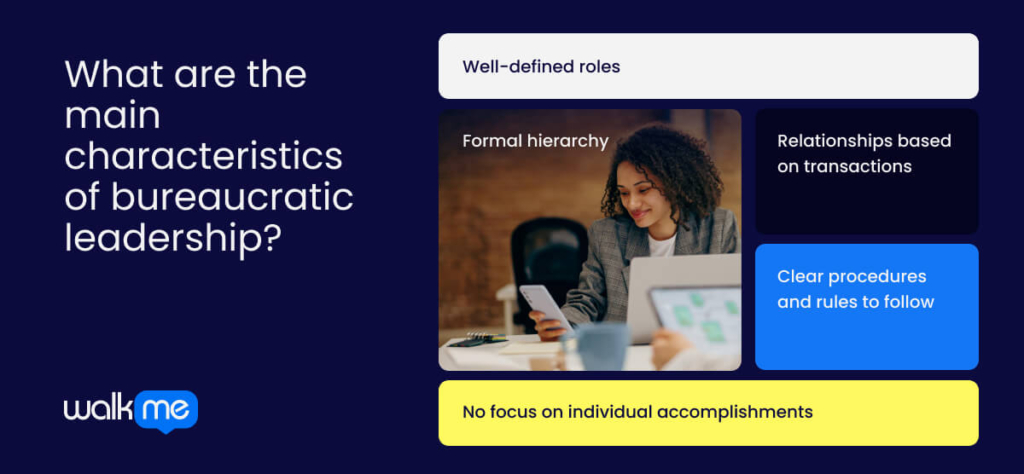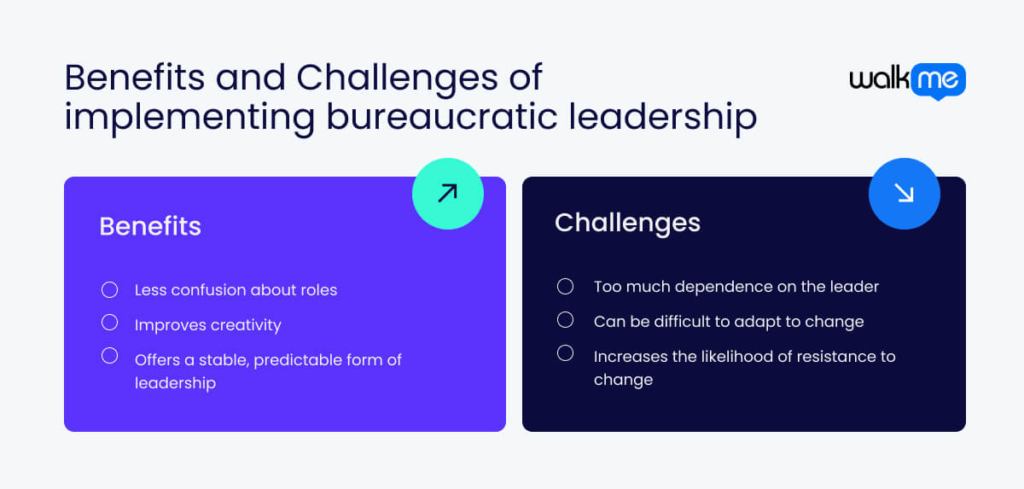Leadership is a key part of organizational transformation. It guides the team through challenges and opportunities. Various styles, including bureaucratic leadership, can assist with your leadership vision.
This style relies on a rigid structure to create efficient systems. It helps a business run well because employees understand their roles and the reporting hierarchy. Bureaucratic leadership is common in factories and large corporations.
In this article, we will define bureaucratic leadership, compare it to other styles, look at examples of bureaucratic leaders and their main characteristics, and discuss the pros and cons of this leadership style.
What is bureaucratic leadership?
Bureaucratic leadership is a style that emphasizes following established rules, procedures, and a strict chain of command. Decisions are made based on a clear hierarchy, ensuring consistency and order.
Sociologist Max Weber first introduced the concept, observing how organizations use strict rules to maintain efficiency. Later, sociologist George Ritzer expanded on this idea with ‘McDonaldization,’ using McDonald’s as an example of a bureaucratic structure focused on efficiency, predictability, and uniformity.
How is bureaucratic leadership different from other leadership styles?
In bureaucratic leadership, the leader expects employees to follow set rules and procedures. This style promotes efficiency through clear guidelines and expectations.
Here’s how it differs from other leadership styles:
Autocratic leadership
Like bureaucratic leadership, the leader controls decisions. But, there are no strict rules, giving the leader more flexibility. The focus is still on efficiency and results.
Democratic leadership
Unlike bureaucratic leadership, democratic leaders allow employees to give input. The leader makes the final decision, but there is more teamwork and collaboration. Efficiency is not the main focus here.
Transformational leadership
Transformational leadership is the complete opposite of bureaucratic leadership. The leader inspires employees to be creative and think outside the box. The goal is to drive change with less emphasis on strict rules or control.
What are the main characteristics of bureaucratic leadership?

The vital characteristics of bureaucratic leadership are:
Well-defined roles
In a bureaucratic organization, every employee must follow specific rules. Bureaucratic leaders give employees tasks and provide a clear framework for daily activities. This helps employees understand their roles and stay informed about their job functions.
When employees know their roles, they can perform their tasks well. The system focuses on placing the right person in the right position. Each employee has the skills needed for their defined roles. This structure allows employees to improve their performance through regular practice.
Formal hierarchy
Bureaucratic management has a clear ranking of authority. There are clear arrangements for how employees handle jobs.
In this management style, you can guide employees through specific rules and policies. The command structure flows downwards, which means that you make important decisions at the top and communicate them to lower-ranked employees.
Managers assign tasks to keep things clear and efficient. They also check employees’ progress toward their goals.
Relationships based on transactions
Employees often rely on help from others to complete their tasks. This can make workplace relationships feel more transactional than personal. It also creates clear boundaries around job responsibilities.
The bureaucratic framework focuses on performance and achieving goals. Leaders set these goals and define how employees should complete their tasks well. Task-oriented leaders might create schedules for their teams. This helps focus on the most important needs and the standards for each task.
A strong understanding of the company, key processes, and how to assign tasks can help reach the set goals. Leaders also need to stay focused on tasks to be effective.
Clear procedures and rules to follow
Guidelines and rules give employees a clear plan for their work. They provide structure and direction. These rules guide behavior and daily tasks. Employees know what to do for both small tasks and bigger projects. This clarity helps them handle different situations.
In bureaucratic leadership, procedures control the workplace. There is little room for flexibility or personal choices. This strict setup ensures consistency across the organization. It keeps things running but limits creativity and new ideas.
Bureaucratic leaders focus on efficiency. They aim to reduce mistakes and increase employee productivity. By following rules, they create a stable work environment.
No focus on individual accomplishments
In bureaucratic leadership, the whole team works together toward a common goal. There is no focus on individual achievements.
Unlike other leadership styles that value group decisions, bureaucratic leadership seeks consistency. This style promotes fair and equal treatment among employees. Leaders use rules to manage behavior without showing favoritism.
Fairness is key in this system. It reduces discrimination by treating everyone equally. No matter their position, employees face the same rules and consequences.
What are some examples of bureaucratic leaders?
Here are some prominent examples of bureaucratic leaders:
Shinji Sogo
Shinji Sogō was the fourth president of the Japanese National Railways. He led the bullet train project. He used bureaucratic management. This created a method that ensured all workers followed the rules. Under his leadership, Japan’s railway system made great progress.
Sogō focused on modern workplace specialization. He set strict rules that helped achieve one of the greatest engineering feats in history. As a result, Japan’s bullet trains are now a common form of transportation.
Alfred Sloan
Alfred Sloan, the CEO of General Motors (GM), focused on setting clear rules and procedures. But, he also saw the value of creativity and innovation. He transformed GM from a loose group of businesses into a model for modern companies.
Sloan reorganized GM into five divisions, each making cars at different price levels. He decentralized production, giving each division the freedom to compete for more business. At the same time, he kept a strong central office to manage the company’s policies.
Steve Easterbrook
While at McDonald’s, Steve Easterbrook ensured that all employees followed the rules. He wanted staff to make fewer decisions and work efficiently, which helped McDonald’s maintain high performance across all its locations.
Easterbrook focused on improving efficiency in over 36,000 restaurants in more than 100 countries. His restructuring plan was the biggest in the company’s history. It cut unnecessary management and store positions. He also shifted focus to customer needs and adapted to local markets.
Harold Sydney Geneen
Harold Geneen was the CEO of the International Telephone and Telegraph (ITT) Corporation. This American company made special parts for energy, aerospace, transportation, and industrial markets.
Geneen helped the brand grow into a billion-dollar company. Under his coaching leadership, the company’s revenue increased from $765 million to $8.5 billion. By the 1970s, ITT had an annual growth rate of 10%.

What are the benefits of bureaucratic leadership?
The most important benefits of bureaucratic leadership are:
Less confusion about roles
Bureaucratic leadership makes roles, jobs, and relationships clear. This setup creates clear boundaries for job responsibilities. In this system, relationships are impersonal and focused on roles. This helps staff work well toward goals.
It also reduces confusion. Defined roles mean managers and employees know what to expect. This clarity helps team members understand their place in the organization. It builds confidence by outlining their expectations, roles, and duties.
Improves creativity
In bureaucratic leadership, creativity and innovation often come from those in authority. This leadership style supports new ideas and strategies for easier management. It encourages fresh concepts and management techniques.
The focus is on understanding consumer behavior and achieving results. Because the approach is predictable, there is little risk of failure.
Offers a stable, predictable form of leadership
Bureaucratic leadership increases efficiency by using standardized procedures. Tasks can be divided based on expertise, and employees perform each task in a structured way.
You can make decisions using clear, impersonal rules, which helps reduce bias in giving resources and opportunities. The approach focuses on results and is reliable because it follows predictable steps. It also keeps the organization stable by treating people in different roles fairly.
What are the challenges of implementing bureaucratic leadership?
The main challenges of implementing this type of leadership are:
Too much dependence on the leader
Bureaucratic leaders are often seen as rigid. They adhere to rules and procedures, which can slow innovation and make it hard to adapt to today’s fast-changing business world.
Strict procedures can also limit employees’ freedom and creativity, lowering motivation and hurting performance. Employees may rely too much on their leader for decisions and direction, which prevents them from working independently and building their skills.
Can be difficult to adapt to change
Bureaucratic leaders often struggle with change because they follow rigid rules. The purpose of bureaucracy is to keep things running the same way. But the world is always changing, so flexibility is important.
The strict decision-making process prevents employees from finding new solutions to problems. A better option here could be adaptive leadership. This approach allows more flexibility and quicker adjustments and ensures that organizations use different styles of leadership for various purposes.
Increases the likelihood of resistance to change
Bureaucratic systems often create resistance to change. Employees get comfortable with routines supported by their leaders, so when new ideas are introduced, they may be slow to accept them.
Bureaucratic leadership can be a barrier in small companies. It slows down decision-making and reduces flexibility, making it harder for the company to grow and adapt. When changes are needed, the process becomes more difficult.
Use a bureaucratic leadership approach if you are an established, regulated business
Bureaucratic leadership brings order and consistency to an organization. By following clear rules, tasks are done correctly, reducing mistakes and improving reliability. However, it also affects employees in different ways.
Employees know their roles and how to do their jobs. This clarity reduces confusion and boosts efficiency. It also helps them set goals for personal growth. Plus, it creates a fair and stable workplace, which can motivate employees.
On the downside, this style can lead to micromanagement. Leaders might watch employees too closely, causing discomfort and lowering motivation. It can also limit growth. Employees may feel they can’t question decisions or take initiative. They must stick to strict tasks, which can slow their development.
So, it’s important to consider both the benefits and downsides before choosing this leadership style.
FAQs
A bureaucratic leadership style might not be ideal for companies that value creativity or support employees’ unique strengths. It can also be challenging when requests must pass through many levels of employees and managers before reaching decision-makers.
Bureaucratic leadership is useful in several industries, including construction, intelligence, healthcare, engineering, security, and education. It is essential for large and complex organizations that need a clear hierarchy for effective management.

